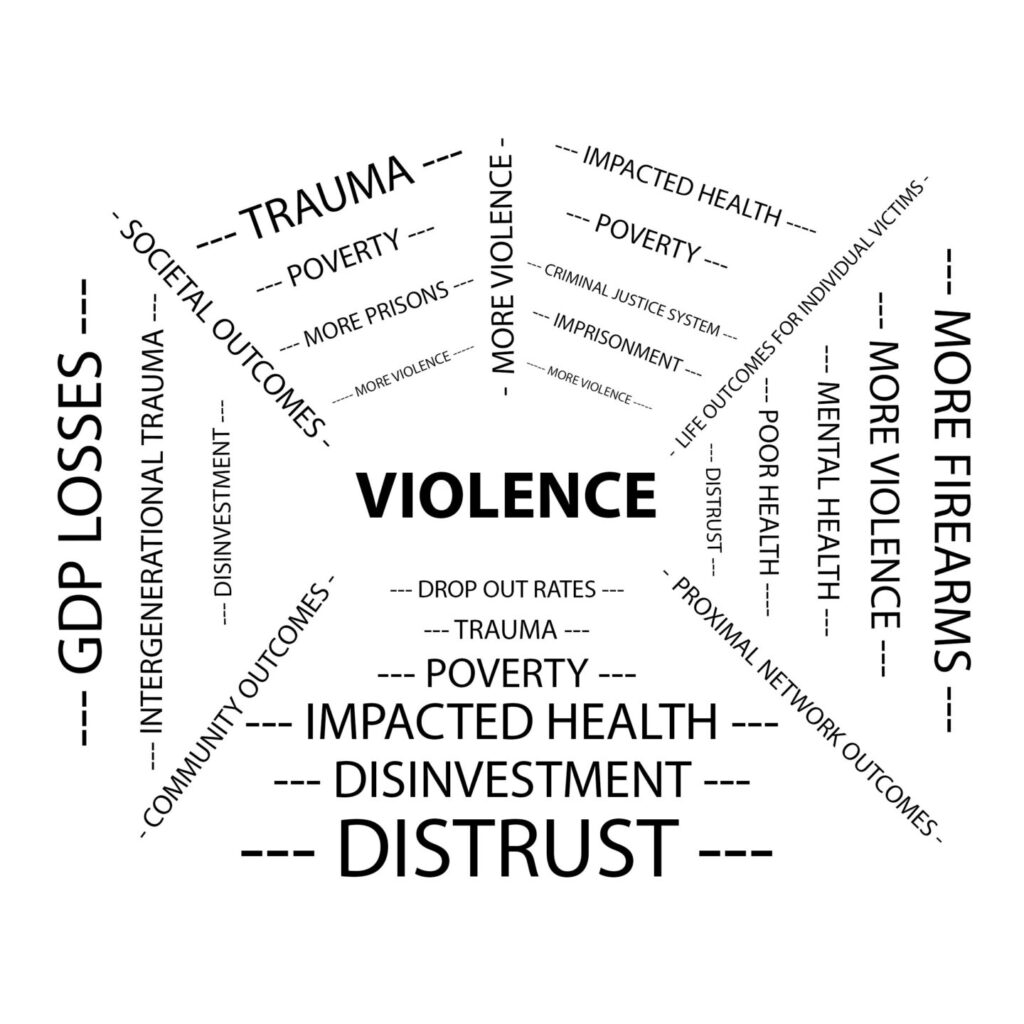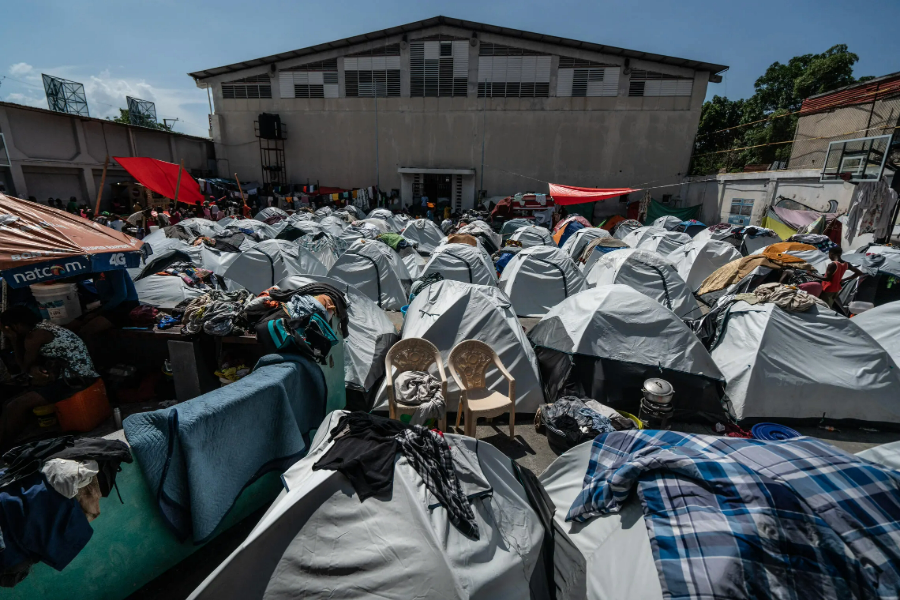Globally, almost 80% of all violent deaths are non-conflict non-terrorism-related homicides – many committed with firearms. This calls for more action to save current and future generations from the scourge of firearms-related violence that spreads in our cities, towns, communities and streets.
Violence weaves a tangled web
While human suffering from violence goes beyond quantifiable metrics, the financial costs of homicides and injuries from firearms-related violence are increasingly well understood and measured. [1] There is a growing body of research documenting how much a single homicide costs a city or the foregone GDP due to violence. However, the armed violence research community tends to tread lightly when measuring the ‘reverberating’ impacts of firearms-related violence – sometimes also referred to as ripple events.[2]
As a result, we may be failing to fully account for cascading harm, transmission events, and vicious cycles, such as poor life outcomes, retaliatory spirals, and interrelated forms of violence. Conversely, we may be underestimating the prevention payoff. This means that we could be missing the full scope of harm from firearms-related violence when it occurs and failing to claim the returns when it is prevented.
Reverberating impacts refer to the outwardly rippling, interconnected, and prolonged web-like network of consequences from an act of firearms-related violence.[3] An effort to map the reverberating impacts from firearms-related violence would investigate shootings, not just as singular or discrete events between individuals, static in time and place, but rather as starting nodes that trigger threads and spirals of harm.
For example, one grave consequence from an act of violence can be more violence; and such offspring events can come in the way of retaliatory cycles and/or interrelated forms of violence.[4] The effort to map the reverberating impacts from firearms-related violence would also examine the channels of influence through which these threads and spirals of harm spread and reinforce each other.
While it is challenging to measure a counterfactual (e.g., how many retaliatory cycles are prevented when a single act of violence is prevented) or establish causality between exposure and outcomes (e.g., a child witnessing violence causes an impoverished adulthood), attempting to do so -in a systematic way- could be transformational. Having a widely agreed framework to understand and measure the reverberating impacts from firearms-related violence can lead to a stronger business case for facing it as the universal and costly scourge it is. In an environment of shrinking budgets, we need this evidence to make a louder case for violence prevention and its cost-effectiveness.
Firearms-related violence is costly and contagious
A 2024 report by the National Institute for Criminal Justice Reform (NICJR) found that in Columbus, Ohio, USA, a fatal shooting, with one suspect, had a governmental cost of USD 2,126,931. This figure accounted for crime scene responses, medical expenses, criminal investigations, incarcerations costs, victim and social services, and lost tax revenue.[5] Nationally, firearms-related violence is estimated to cost the US around USD 557 billion per year, about 2.6% of its GDP.
In Latin America and the Caribbean – a region where only 8% of the world’s population resides yet accounts for one third of global homicides, disproportionately committed with firearms – the Inter-American Development Bank estimated that the costs of crime and violence reached 3.44% of its GDP in 2022. This figure accounted for losses in human capital, spending on crime mitigation by private business, and public spending on criminal justice. To put into context, the financial costs of crime and violence in the region is about double the budget for social assistance programmes.
As significant as the financial costs are, the reverberating impacts from firearms-related violence spread well beyond economic impacts.[6] Public health literature can be instrumental in understanding wider costs – and the chain of infection associated with the spread of firearms-related violence and its consequences. This is because community violence, which is often perpetrated with the presence of firearms, behaves like an epidemic. Violent behaviours – just like a contagious disease – cluster, transmit, and spread, with the highest predictor of future violence being close exposure to past violence.[7]
A 2023 report by New York University outlined costs incurred by individual victims of violence, taking inspiration from the ‘burden of disease’ literature. This model adds costs associated with a condition that would not have been incurred should the disease not exist. Researchers categorized tangible direct costs, tangible indirect costs, and intangible costs. In this model, tangible direct costs are medical treatment, care, and criminal justice expenses; tangible indirect costs are income losses and reduced productivity; and intangible costs are values for injury, such as pain, reduced quality of life, and fear, or the Value of Statistical Life.
Further, the NICJR report outlined some indirect costs from violence at the community level. The research documented that violence leads to decreased property values, business and investment flight, community tension and trauma, increased firearms possession, and more use of violence to resolve disputes. It also found intergenerational impacts, noting that children exposed to violence tend to have worse life outcomes, such as impacted health, lower school performance, higher likelihood of impoverishment, and more contact with the criminal justice system.[8]
An ecological model to study violence as a public health issue, outlined by the World Health Organization, in 2002, offered four levels to understand the complex interplay of relations and environmental factors that affect and are affected by violence. These levels being individual, proximal social relationships (such as close family), community, and societal. In analyzing the reverberating impacts from firearms-related violence, this ecological model could offer an initial sketch to map the threads and spirals, relationships and channels, and visualize how different harms from violence outspread from a single shooting event.
A research agenda to untangle the reverberating impacts
This commentary outlines a research agenda to develop a framework that better captures the full scale and scope of the reverberating impacts from firearms-related violence, because there is still so much harm from violence and its consequences that we do not fully capture or understand yet.
As a first step, we need to define and more clearly differentiate between direct and indirect costs; tangible versus intangible costs; ripple, cascading, and offspring events; first-second-and-third order effects; and a better definition of reverberating impacts too. Having a broad agreement on terms, and how to measure them, will be a solid starting place.
As a second step, we need to map the different threads of harm that outspread from a shooting event, like radial lines from the center of a spider web. This mapping effort could help identify key components in the chain of infection and capture a broad range of harm from an incident, starting with:
- More violence: one thread could illustrate violence leading to more violence, including retaliatory cycles and/or interrelated forms of violence.
- Individual outcomes: the next thread could focus on unpacking life outcomes for individual victims, following the burden of disease model, such as medical expenses, income losses, pain, and fear.
- Proximal network outcomes: a further thread could capture life outcomes for the close social network of a victim, separated by relationships, age, and gender. These outcomes could include, for example, poverty, drop-out rates, physical and mental health[9], and contact with the criminal justice system.
- Community outcomes: the following thread could capture community-level outcomes. These can include, for example, distrust, disinvestment, and intergenerational trauma[10].
- Societal outcomes: then a different thread could focus on societal outcomes, like forgone GDP or opportunity costs in governmental expenses, including criminal justice expenditures.
As a third step, we need to identify how these threads connect with each other to form spirals. This exercise can help identify pathways of influence and reinforcing effects between different categories of harm. Taken together, the radial threads and spirals, originating from one incident, can illustrate the many ways the reverberating impacts of firearms-related violence permeate all of society.

Three clear benefits emerge from having a more comprehensive framework:
- Academically, it will help better understand the full scale and scope of the consequences of firearms-related violence.
- Budgetarily, it will help make a stronger case for the prevention payoff.
- Operationally, it can help practitioners more clearly identify intervention points to stop the spread of firearms-related violence and its consequences.
The budgets from many national and local governments, as well as in the UN, are facing significant pressure to cut spending. Not surprisingly, the OECD report on States of Fragility found that resources for prevention are diminishing. This is all happening when community violence intervention is at a crossroads: continued growth as a field with a well-connected public safety infrastructure or disinvestment that threatens to “dismantle its progress just as its proving its worth”. Considering current pressures and what is at stake, now, more than ever, we need to invest astutely. Investing in violence prevention is, without a doubt, worth it. And the louder we can make the case, the better chance we stand.
[1] This commentary recognizes that human suffering from violence is beyond quantifiable metrics. It is only an attempt to inform a research agenda and policy decisions by investigating the magnitude of the broader consequences from firearms-related violence, which tend to be overlooked or underestimated.
[2] In recent years, researchers have made significant advances in shedding light on the many costs of violence, including human and economic costs. See, for example, reports from New York University and Everytown for Gun Safety, as well as The mental health consequences of interpersonal gun violence: A systematic review.
[3] This is a working definition to illustrate the broad spread of the ‘reverberating’ impacts. This commentary later argues for the need to develop a more detailed definition with buy-in from the research community.
[4] Retaliatory spirals of violence among gang-involved individuals are well documented, with one study from the University of California in Los Angeles finding their contagion level as triggering twice as many offspring events as non-gang related incidents. It has also grown increasingly clear that different forms of violence are interrelated. A report from the Peace in Our Cities network highlighted that individuals involved in one form of violence (e.g., street shootings) are usually also involved in different forms of violence (e.g., gender-based violence). The report also finds that bullying at schools increases the likelihood that those involved will suffer or perpetrate violence outside of schools.
[5] Also, for example, consider the city of Bristol, England. In 2020, the Bristol City Council, based on the methodology of the Home Office, estimated the cost of a single homicide at £3,217,740 (approximately $3,966,170). This figure accounts for lost output, health services, victim services, and police expenses, among other direct and indirect cost categories.
[6] Globally, the Global Peace Index estimated that, for 2022, interpersonal violence had an economic impact of $2.6 trillion.
[7] See, Cure Violence Global.
[8] Studies have also found that adverse childhood experiences (ACEs) may be significant antecedent risk factors to future firearms-related violence, see Childhood Trauma Exposure and Gun Violence Risk Factors among Victims of Gun Violence.
[9] As a further example of the growing body of literature, Rutgers University recently released a study suggesting a link between community firearms-related violence and impacted dental health.
[10] See, for example, Beyond Measure: Gun Violence Trauma.

